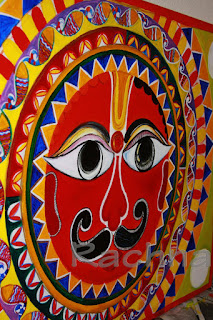Duration: 6 weeks
Tasks done and Processes:Contextual Inquiry, Literature Review
‘Warli’ painting is one of the age old styles of mural /wall painting practiced by a small tribe based in ‘Thane’ District of Maharashtra state in India.
’ Warli’ draws its name from ‘Warla’ which in the tribe’s dialect means ‘a piece of land’. ‘Warli’ painting’s origins are said to date back to 2500BC to 3000BC.It bears striking similarities between the patterns illustrated on ‘Bhimbetka’ caves of Madhya Pradesh.

This dated mural painting style uses the basic graphic/geometric patterns and the rhythmic repetition of these patterns is used to depict the daily lives of this tribes. A beautiful interplay of simple forms as ‘Circle’,’ Triangle’ and ‘Square’ is used to adorn the walls on special occasions as marriages and harvest season.
The basic constituent elements of this art form, namely 'the circle', 'the triangle' and 'the square',draws its inspiration form elements of nature for example the circle representing the sun and the moon, the triangle inspired from mountains.Of all the 'square' seems to obey a different lineage and apparently is figment of human imagination, indicating a sacred enclosure ‘sanctum sanctorum’(to draw an analogy ,one can put it as a form inspired from the concept of ‘Garbhgriha’ of Hindu temples which houses the sacred of all ) or a piece of land.

A classic visual is resulted by varying the scales of these elements and creating a conjunction of these elements. For example ‘human figurines’ are represented by conjugation of two inverted triangles pivoted at a point, the upper triangle symbolizes the trunk of human stature where as the lower triangle portrays the pelvis of human. The circle is used not only for the direct depiction the ‘sun’ but also is an integral part of human figure depiction representing the head.
The most interseting of the facts is the usage of all organic and eco friendly raw materials for the illustration of this art form. It’s completely in agreement to the currently prevailing outcry of ‘Sustainability’ and usage of biodegradable ingredients, putting no extra burden on mother earth from bio-hazard point of view. Traditionally these paintings are done within the enclosures of their adobes/ huts. The background walls are prepared of a mixture of earth and cow dung, making a red ochre background ‘Geru’ for the wall paintings. The traditional ‘Warli’ practitioner uses only white for their paintings. Their white color used is a mixture of rice paste and water with a binding agent for gluing on the wall. The artisans use a bamboo stick as their paintbrush. Since these are occasional practices, there is an apparent lack of defined sharp edges and regularity in depiction of the murals.
What entices me most about this art form is the ‘simplicity’ of illustration and usage of plane geometric patterns as ‘Circle’ triangle’ and ‘square’. As is popularly quoted by designers ‘less is more’, this art for inspired me to believe ‘Simple is beautiful’.We the ones who belong to the fraternity of designers, are so hooked up by ‘cool look and feel’ factor that ‘simplicity’ tends to take a back seat. Thorough research of aboriginal and dated as well as contemporary art forms practiced in India, unfolds the hidden ‘Design thinking and practices’ that prevailed and lays the foundation of the various art forms of our diverse nation.
Here I take the pleasure to put forth a few of my attempts to depict this ancient art form of Maharashtra. I take pride in portraying some of my illustrations of ‘Warli’ and they are representative of or symbolic of the essence of engineering drawings and architectural detailing, apparent in the well defined geometric patterns with smooth edges! Thanks to my acquired instinct: ‘An eye for detail’ and extensive drawing /drafting background.













